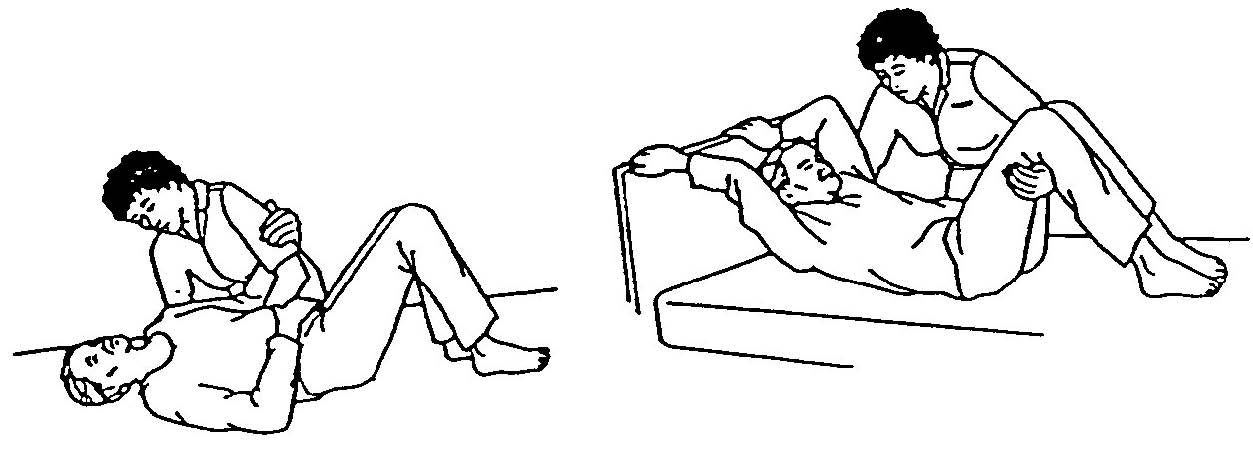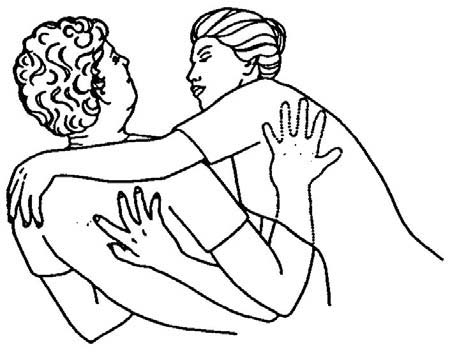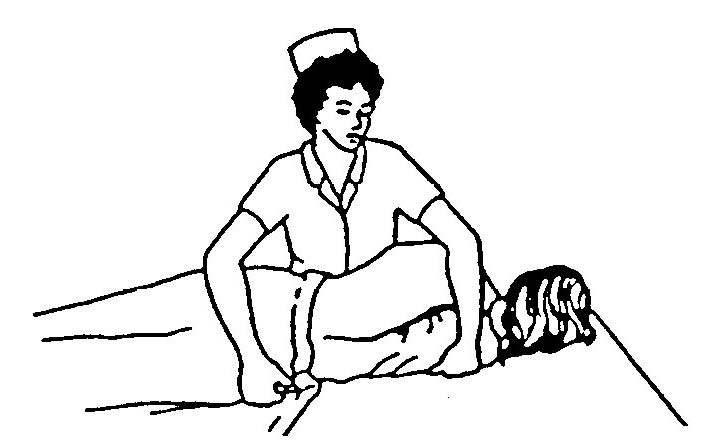 This is the Archived Desktop Edition.
This is the Archived Desktop Edition.
You should be transferred to the Newest Edition for Desktop and Mobile within 2 seconds.
Basic Patient Care Procedures
2-5
2-5. TECHNIQUES IN MOVING BED PATIENTS
a. Preparation Before Moving Patients. The principles of body mechanics should be employed when assisting or moving the patient. Important points that should be resolved before the procedures start include the following:
(1) Check the medical officer's orders and the nursing care plan card in order to determine any restriction of the patient's movement and to know what the patient should be encouraged to do. Explain to the patient, how he can assist in the procedure.
(2) Obtain the equipment and the assistance necessary before moving patient.
(3) Ensure that the bed wheels are locked; and start with the bed level (unless contraindicated).
b. Moving a Patient Up in the Bed. There is a tendency for the mattress and the patient to slip down when the head of the bed has been elevated. Lower the head rail to a level position and move the mattress up before repositioning the patient, as free space at the foot of the bed is needed to adjust the bedding.
(1) Moving the mattress up. This procedure is used when the patient can assist and raise his buttocks off the bed on signal. Stand behind the head of the bed and grasp the mattress; give the signal; brace your forward thigh against the bed; and slide the mattress and patient up. If the patient cannot assist, ask for help. Instruct the assistant to stand at the opposite side of the bed and grasp the mattress. On signal, slide the bed mattress and patient up.
(2) Moving the patient up. Pull the pillow upright; tell the patient to reach back and grasp the bars at the head of the bed and bend his knees; slide one arm under the patient's shoulders and the other arm under his buttocks (figure 2-8); on signal, have the patient pull with his arms and push with his feet while you slide him upward. When the patient cannot assist, the assistant, standing on the opposite side of the bed, likewise slides his arms under the patient and, in unison, both shift their weight and slide the patient up.
Figure 2-8. Moving a patient up in bed.
(3) Using a drawsheet. A drawsheet may be used to help move a helpless patient. An assistant is needed. Loosen the sheet and roll it close to either side of the patient's body. In unison, grasp the rolled sheet and slide the sheet and patient upward. Then smooth the loosened sheet free of all wrinkles, tighten, and tuck it under the sides of the mattress.
c. Assisting a Patient to Raise Head and Shoulders. This procedure is used to remove or replace the pillow or to assist the patient into a sitting position. Stand facing the head of the bed with one foot advanced. Slip your arm nearest the patient under his axilla and brace this hand against the back of his shoulder. Tell him to bend his knees to relieve strain on his abdominal muscles and to brace the hand of his supported arm against the back of your shoulder. By linking arms, you and the patient make use of shoulder and chest muscles to lift his body weight (figure 2-9). This linking of arms provides mutual support. At the given signal, raise his back and shoulders by shifting your weight from the front to the rear foot. Use your free hand to support his head or to remove or replace the pillow.
Figure 2-9. Raising head and shoulders.
d. Moving a Patient to the Side of The Bed. A patient is easier to move or lift when he is close to the side of the bed since the medical worker can be closer to the patient's center of gravity. Consequently, other procedures require less strain. When working alone move the upper and lower parts of the body separately.
To move his upper body, slide one arm under his head and shoulders and one arm under his back; then slide his upper body toward you. To move his lower body, slide one arm under his hips and one under his thighs, and then slide his lower body toward you. Realign his shoulders, hips, and legs.
e. Turning a Patient on His Side. When working alone, always turn the patient toward you. Stand on the side of the bed toward which the patient is to be turned. Flex his knees toward you. Place one hand on his far shoulder and the other on his far hip. Bracing your body against the side of the bed, gently roll the patient toward you. Now go to the opposite side of the bed. Slide your arms under the patient's hips and draw his hips toward you, toward the center of the bed. Flex his upper leg forward on his extended lower leg to prevent him from rolling backward. Check his shoulder alignment. His lower arm should be in front of his chest or extended along his back, but not caught under his body (figure 2-10). Return to the original side of the bed. Arrange the pillow to support his head. Use two additional pillows to support his upper arm and upper leg and to maintain shoulder and hip alignment.
Figure 2-10. Turning a patient on his side.



